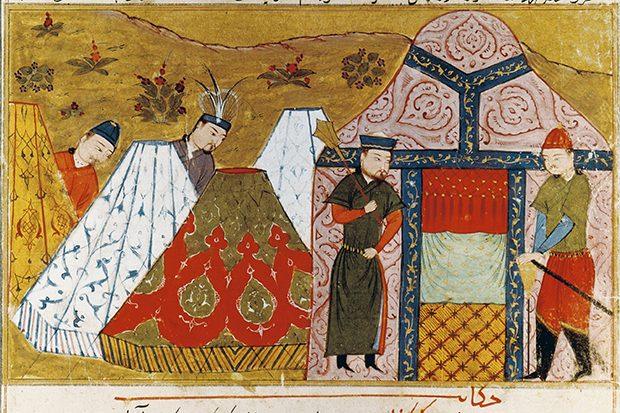
How the Mongol Empire Conquered and Controlled a Vast Territory
The Mongol Empire, a name synonymous with both awe-inspiring conquest and devastating brutality, stands as one of history’s largest contiguous empires. Spanning over 24 million square kilometers at its zenith, its shadow stretched from the steppes of Central Asia to the heart of Eastern Europe, profoundly impacting the course of world history. This essay will delve into the multifaceted narrative of the Mongol Empire, exploring its origins, its breathtaking expansion, its sophisticated administrative structures, its devastating military tactics, its unexpected cultural contributions, and its eventual fragmentation. We will examine the key factors that contributed to its remarkable rise and its ultimate decline, revealing the complexities of this powerful, albeit often brutal, global force.
The Forging of an Empire: Temüjin and the Unification of the Mongols
Before the emergence of the vast Mongol Empire, the Mongolian steppe was a patchwork of fiercely independent nomadic tribes, perpetually locked in a cycle of conflict and alliances. Into this chaotic landscape stepped Temüjin, a charismatic and ruthless leader who would eventually become known as Genghis Khan (roughly translated as “Oceanic Ruler”). Born into relative obscurity, Temüjin’s early life was marked by hardship and treachery. He witnessed firsthand the brutality of tribal warfare and the constant struggle for survival. These experiences, however, forged his resilience, his strategic acumen, and his unwavering ambition.
Temüjin’s ascent to power was not a smooth one. He skillfully navigated a complex web of tribal rivalries, forming strategic alliances and employing both diplomacy and force to consolidate his power. His key achievement was the unification of the disparate Mongol tribes under a single banner. This unification wasn’t simply a matter of military dominance; it required a deep understanding of Mongol culture and tradition, the ability to inspire loyalty, and the shrewd utilization of kinship ties and political marriages. His success stemmed from his capacity to build a powerful coalition, based on a shared sense of identity and a common goal – the creation of a unified and dominant Mongol nation.
The Yassa, Genghis Khan’s legal code, played a pivotal role in unifying the empire. While often portrayed as a brutally enforced system, the Yassa established a framework for governance, promoting order, justice, and – importantly – social cohesion within the disparate Mongol tribes. It addressed various aspects of life, from military organization to property rights, and ensured a degree of consistency across the vast and diverse territories under Mongol rule. While often harsh in its punishments, it provided a necessary framework of law and order that fostered a sense of stability and predictability, essential for managing such a sprawling empire.
The unification of the Mongols marked not merely the beginning of the empire; it created the very foundation upon which its future expansion would be built. The unified Mongol hordes, now a formidable military machine, were ready to unleash their power onto the world.
Military Genius and the Blitzkrieg of Conquest
The Mongol military machine was unlike anything the world had previously seen. Genghis Khan’s genius lay not only in his strategic vision but also in his ability to build and deploy a highly effective military organization. This organization was based on a highly disciplined decimal system, with units of ten, a hundred, a thousand, and ten thousand soldiers, all operating under a strict chain of command. This system ensured effective communication, rapid deployment, and coordinated maneuvers on the battlefield.
Mongol military tactics were characterized by their mobility, speed, and ferocity. They were master horsemen, capable of covering vast distances quickly and deploying devastating flanking maneuvers. Their mastery of archery, particularly from horseback, gave them a significant advantage over many of their opponents. The use of composite bows, capable of piercing armor at great distances, was a key factor in their battlefield successes. Moreover, they employed sophisticated reconnaissance and intelligence-gathering techniques, allowing them to anticipate enemy movements and exploit their weaknesses.
The Mongol armies weren’t just skilled; they were incredibly adaptable. They could fight effectively in diverse terrains, from the open steppes to the mountainous regions, and adapted their tactics to suit the circumstances. Their use of siege warfare, though initially less sophisticated, steadily improved, allowing them to conquer fortified cities and strongholds.
The conquests under Genghis Khan were characterized by a brutal efficiency. While diplomacy was employed where useful, the Mongols were renowned for their ruthlessness, often leaving a trail of devastation in their wake. The sack of cities like Baghdad, a once-magnificent center of learning and culture, stands as a grim testament to their power. This brutality, however, served a strategic purpose: it instilled fear and discouraged resistance, facilitating further conquests.
However, it’s crucial to avoid a simplistic portrayal of the Mongol conquests as purely acts of random destruction. While undeniably brutal, their campaigns often followed clear strategic objectives. The conquest of specific cities and regions were often planned, meticulously targeting areas of strategic importance, whether for trade routes, access to resources, or the weakening of opposing powers.
The Expansion Under Genghis Khan’s Successors: A Century of Conquest
Genghis Khan’s death in 1227 didn’t signal the end of the Mongol Empire’s expansion. His successors, notably Ögedei Khan, continued the relentless campaign of conquest. Ögedei’s reign witnessed further incursions into Eastern Europe, leading to the devastating subjugation of Kievan Rus’, a significant blow to the already fragmented Eastern European political landscape. The Mongols extended their influence as far west as Hungary and Poland, leaving a lasting impact on the region’s political and social structures.
The Mongol Empire’s expansion wasn’t a uniform process. Different khans pursued different strategies, some prioritizing consolidation of existing territories, while others focused on further territorial expansion. This varied approach led to both periods of rapid growth and periods of relative stability.
The administrative structure of the empire played a vital role in managing its vast territories. While the central government in Karakorum, the newly established capital, maintained ultimate authority, the empire was divided into smaller, more manageable units, often governed by local administrators. This system allowed for a degree of autonomy while ensuring overall loyalty to the Great Khan. This decentralized administration was crucial in facilitating effective governance across a vast and diverse empire.
The Pax Mongolica, a period of relative peace and stability across the empire, stands in contrast to the brutality of the initial conquests. While not entirely peaceful, this period saw a significant increase in trade along the Silk Road, connecting East and West in an unprecedented manner. This facilitated the exchange of goods, ideas, and technologies, fostering cultural exchange and economic growth across Eurasia. However, the Pax Mongolica was not a uniform experience. The level of peace and prosperity varied significantly across the empire’s many regions, depending on the local rulers and the specific circumstances.
The Mongol Empire’s Administration and Economic System: A Surprisingly Sophisticated Structure
Despite its image as a purely military power, the Mongol Empire developed a surprisingly sophisticated system of governance and economics. While the initial conquests were driven by military might, the subsequent administration required a level of organizational skill rarely seen in empires of that scale. The empire’s vast size and diverse population demanded a complex administrative framework to maintain order and extract resources. This was achieved through a hierarchical structure, with the Great Khan at the apex, followed by regional khans and local administrators.
The Mongol administration utilized a system of tax collection, ensuring a steady stream of revenue to fund the military, administration, and large-scale infrastructure projects. The implementation of a unified currency system and standardized weights and measures facilitated trade and economic activity across the empire. The Yam, a sophisticated postal relay system, allowed for swift communication across vast distances, enhancing the empire’s administrative efficiency.
The economic prosperity of the empire was largely driven by trade. The Mongols actively protected trade routes, most notably the Silk Road, leading to a significant increase in the flow of goods, ideas, and technologies between East and West. This exchange of goods included silks, spices, porcelain, textiles, and precious metals, generating significant wealth for the empire and its subjects. However, this prosperity wasn’t uniformly distributed; the benefits of trade were disproportionately enjoyed by certain groups and regions within the empire.
The Mongol Empire’s economic system wasn’t just about trade; it also incorporated various forms of taxation, including land taxes, tribute from conquered territories, and taxes on trade. This complex financial system ensured the financial stability and military strength of the empire. However, it also led to periods of economic hardship in certain regions due to overtaxation or unfair practices.
The Seeds of Decline: Internal Conflicts and External Pressures
Despite its immense power and vast resources, the Mongol Empire began to unravel in the 14th century. Several factors contributed to its decline, including internal conflicts, succession crises, and external pressures. The death of successive Great Khans often resulted in power struggles among their heirs, weakening the central authority and leading to fragmentation. The empire’s sheer size made effective governance increasingly difficult, leading to regional autonomy and eventual secession.
The Black Death, a devastating pandemic that swept through Eurasia in the mid-14th century, significantly weakened the Mongol Empire. The pandemic decimated populations across the empire, disrupting trade, agriculture, and the military capacity of the empire. The loss of manpower and the economic disruption created a vacuum of power, which various regional powers readily exploited.
External pressures also contributed to the decline. Revolts by conquered populations, along with the rise of powerful regional adversaries, challenged the empire’s authority. The decline wasn’t a sudden collapse but rather a gradual process of disintegration, with the empire slowly fracturing into smaller, independent khanates.
The fragmentation of the Mongol Empire didn’t mark its complete disappearance. The four successor khanates – the Golden Horde, the Ilkhanate, the Chagatai Khanate, and the Yuan Dynasty – continued to exert considerable influence in their respective regions for centuries, leaving a lasting legacy on the political, cultural, and economic landscape of Eurasia.
The Enduring Legacy: A Transformative Impact on World History
Despite its eventual fragmentation, the Mongol Empire left an indelible mark on world history. Its conquests facilitated unprecedented levels of cultural and economic exchange between East and West. The Pax Mongolica, despite its uneven nature, fostered a period of relative peace and stability, allowing for the free flow of goods, ideas, and technologies across vast distances. This exchange contributed to the dissemination of knowledge and the advancement of various fields, including technology, art, and science.
The Mongol Empire’s influence extended far beyond mere trade. The empire’s administrative systems and legal codes influenced subsequent empires and states. The legacy of Mongol rule is still visible in the languages, cultures, and political structures of many regions.
The Mongol conquests had a profound and lasting impact on the demographic makeup of Eurasia. The movement of people, both during the conquests and in the subsequent years, reshaped the ethnic landscapes of many regions. Moreover, the Mongol Empire’s military techniques and organizational structures influenced warfare for centuries to come, shaping the evolution of military strategy and tactics.
In conclusion, the Mongol Empire’s history is a complex and multifaceted narrative of conquest, administration, cultural exchange, and ultimately, decline. It remains a crucial subject of study, offering valuable insights into the dynamics of empire building, the complexities of governance across vast territories, and the profound impact of human interaction on the shaping of civilizations. The empire’s legacy continues to resonate in the political, economic, and cultural landscapes of Eurasia, a testament to its enduring influence on the course of world history. The study of the Mongol Empire offers valuable lessons on the rise and fall of empires, reminding us of the ephemeral nature of power and the enduring impact of human agency.


